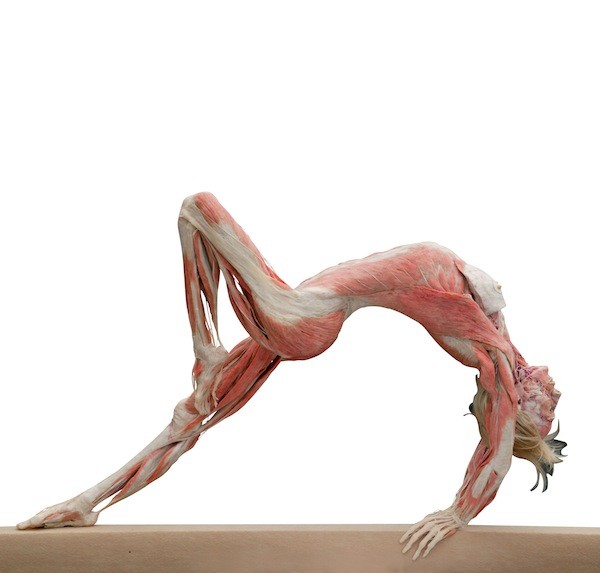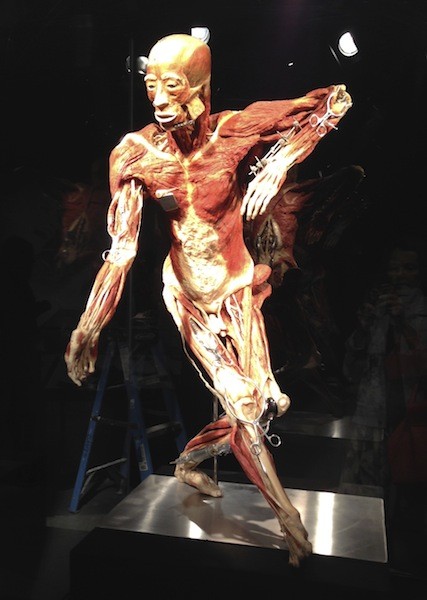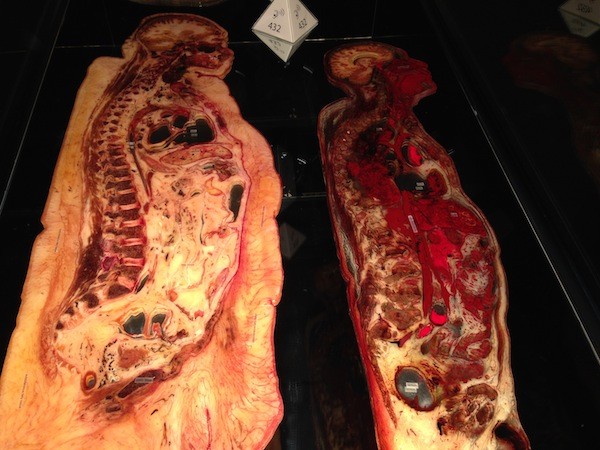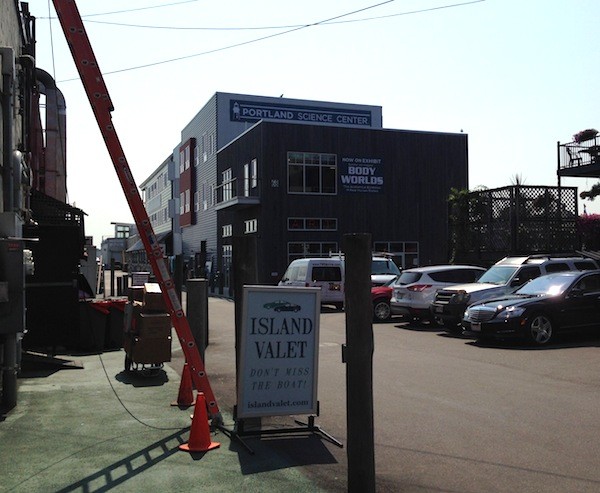
© Gunther von Hagens’ BODY WORLDS, Institute for Plastination, Heidelberg, Germany, www.bodyworlds.com.
All rights reserved.
As a longtime health reporter and former x-ray tech, I’ve been in lots of operating rooms and have witnessed more surgical procedures than I can count. I’ve seen people’s brains, hearts, stomachs, intestines, gall bladders, kidneys, joints, muscles and bones. Surgeons have obligingly stepped aside to allow me a closer view of how a certain body part or system operates — or to explain how something will be repaired or removed. But never have I seen anything like the Body Worlds exhibit at the Portland Science Center. On display are 17 preserved human bodies in various postures as well as about 200 individual organs, organ configurations, and transparent body slices.

© Gunther von Hagens’ BODY WORLDS, Institute for Plastination, Heidelberg, Germany, www.bodyworlds.com.
All rights reserved.
This specimen shows many of the blood vessels inside the head. Many, but not all. Dr. Angelina Whalley, the creative and conceptual designer of Body Worlds exhibits around the world (there are 10), explained to me that it represents only the major vessels. “All the tiny capillaries are not shown,” she said, “because if we would have filled those with polymer as well, it would be so dense you couldn’t look through it. It would be as if you were looking at red tinted skin.
I asked how there could be room for anything else if the head is so jam-packed with blood vessels. “To me, that’s what’s really amazing,” Dr. Whalley replied. “If you think of all the tissue that needs to sit in there and that it is all functioning — that’s really a wonder, that’s amazing.”
What is also amazing is that we were looking at a real head. Every single one of the Body Worlds specimens was once a living human being. We’ve all heard about donating our bodies to science. Dr. Whalley says that since 1980, more than 15,000 people (10 percent from the United States) have signed up to be donors for Body Worlds — to have their bodies preserved and used as educational tools, to be put on display. To date, they have received about 1,500 bodies.
Why do people donate? For different reasons. “Some people say they were totally fascinated with an exhibition,” says Dr. Whalley, “and they understand it’s so important, particularly for lay people, to get a better understanding of their inner selves. Others suffer from a particular disease and want to help physicians understand the disease better so future generations don’t have to suffer that much.”
Whatever their reasons, the results of people’s donations are mind-boggling. The specimen above is called The Totally Expanded Body. Ordinarily, you wouldn’t be able to see all the muscles and organs because they’re tightly packed together, but spaces were created between the various parts and the organs and muscles hang from fine wires, giving us a 360-degree, three-dimensional view of the inside of the body.
The Orthopedic Body (above) is in a dancer’s pose and if you look closely, you’ll see that it has had a few joint replacements. Also, the jawbone has been partly replaced and various bones have been stabilized with fixation devices and metal pins and plates. Look again and you might also notice a pacemaker.
Mark Thompson, Senior Vice President with the Gold Group, the Massachusetts entertainment marketing and promotions company that brought the Science Center and Body Worlds to Portland, was especially interested in the joint replacements. “I’m sort of at that age,” he told me. “To me, the artificial hip was really powerful because it just sits right in perfectly. Not that I thought it wouldn’t, but when you see it for real, it’s got a different feel.”
The technique that gives us such personal and accurate views of the human body was developed by Dr. Whalley’s husband, Gunther von Hagens. The idea came to him when he was an anatomy assistant at the University of Heidelberg’s Institute of Anatomy in the mid-70s. “I saw my first specimen embedded in a polymer block” he states on Body Worlds’ website. “I wondered why the polymer had been poured around the outside of the specimen as having the polymer within the specimen would stabilize it from the inside out. I could not get this question out of my mind.”
The process he eventually developed, which is called plastination, replaces bodily fluids and fat with fluid plastics that harden after going through something called vacuum forced impregnation. It took von Hagens six years to refine the process and it wasn’t until the early 1990s that he was able to do large bodies, which are called plastinates. The plastinates are in poses that show different anatomical structures and simulate how our bodies work when we perform different activities.
Individual body parts are also displayed, sometimes to show the effects of lifestyle choices and diseases — the black lungs of a smoker or the shrunken brain of a person with Alzheimer’s. The cross-sections above — comparing two different bodies — demonstrate the toll that obesity can take on internal organs, pressing against the heart, for instance.
Some displays are meant to simply teach us about our anatomy. For example, our intestines.
When Zeke Wyatt, an assistant manager at the Science Center, first saw the exhibit he says he didn’t know what to think. “I have a weak stomach sometimes,” he admitted, “so I needed the first five minutes, but I couldn’t stop looking at it. From the first exhibit all the way to the end, I learned things — things that you know intellectually from biology class but you don’t have that visual of them. It creates almost this tactile experience for you without touching them.”
Body Worlds is more than an anatomy lesson, says Joseph Gold, Principal for the Gold Group. “It’s edutainment,” he says. “We’re going to entertain you and you’re going to learn something. People come to Body Worlds and they see how lifestyle choices affect the human body and really have the opportunity to change their health. It really has changed people.”
It may have changed some people, but over the 20 years Body Worlds has traveled around the globe, for various reasons, it has also invited controversy. In 2005/2005, the CaliforniaScience Science conducted an ethical review, which is available to read on the Body Worlds website.
Bearing in mind that his role is to promote Body Worlds — the exhibit that is launching the Portland Science Center — Bob Gold recalls the first time he saw Body Worlds. “I was in Philadelphia at the Franklin Institute. We were doing work for them and the head of the museum said it was the most beautiful, the most spectacular, the most engaging exhibit she had ever seen. At that point, I had only seen photographs and I wondered how she could say that. And then I went to see Body Worlds for the first time and she was absolutely right. It is a spectacular exhibit.”
You have until the end of the year to decide for yourself if Body Worlds is a spectacular exhibit. The Portland Science Center is located at 68 Commercial Street in Portland on the Maine Wharf. Check out the Portland Science Center website for hours/ticket prices/directions.
Have you seen the exhibit? Surely, you have an opinion.






Wow! Thanks for writing about this, Diane, I am definitely going to see it! xo